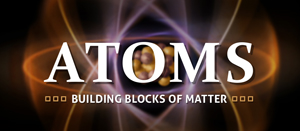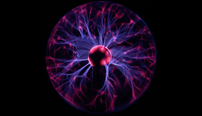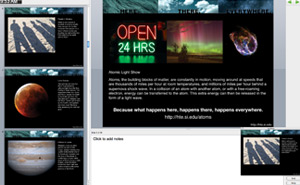


- MAKE YOUR OWN EXHIBIT
- WATCH A VIDEO
- READ A BLOG
- TACTILE & BRAILLE HTE
- AMERICAN SPACES
- PIN SOME IMAGES
- SHARE WITH A FRIEND

Topics: when atoms collide.
Atoms, the building blocks of matter, are constantly in motion, moving around at speeds that are thousands of miles per hour at room temperatures, and millions of miles per hour behind a supernova shock wave.
In a collision of an atom with another atom, or with a free-roaming electron, energy can be transferred to the atom. This extra energy can then be released in the form a light wave.
Read our blog post: Auroras Abound or learn more about Atomic Light Shows.

- Neon Sign.
- In a neon sign, an electric current runs through a tubular glass fixture that is filled with gas. This electric current causes collisions between the electrons and atoms in the neon gas. When various electrons relax, the energy released produces light that has a very specific color that invite us through the diner door.
- Image: Seacoast Signs/J. Ortega
- Aurora.
- Streams of particles with electric charge are continually leaving the Sun and traveling through the Solar System. As these particles approach the Earth, some of them are channeled by the planet's magnetic field toward the North and South poles where they collide with atoms in the Earth's atmosphere. This produces the famous light shows we call auroras, or, more commonly in the Northern Hemisphere, the "Northern Lights."
- Image: Stan Richard. nightskyevents.com
- Supernova Remnant.
- When a massive star explodes, it generates an outgoing blast wave that travels through the space around the now-dead star. This wave heats the gas in this region to a temperature of several million degrees, making the molecules and atoms in the gas vibrate and collide. When the electrons in this superheated gas relax, they release their excess energy mostly in the form of X-ray light.
- Image: NASA/CXC/NCSU/K.J.Borkowski et al.
Where can we observe light emitted by atoms?
Here, there, and everywhere that atoms and electrons collide at high speeds, for example, in neon signs, in auroras, or in supernova shock waves.
Related Resources

"Here, There, & Everywhere" (HTE) is supported by the National Aeronautics and Space Administration under grant NNX11AH28G issued through the Science Mission Directorate.
HTE was developed by the Chandra X-ray Center, at the Smithsonian Astrophysical Observatory, in Cambridge, MA.
Email: cxcpub@cfa.harvard.edu | Phone: 617.496.7941
Follow us: #HTEScience on Twitter






